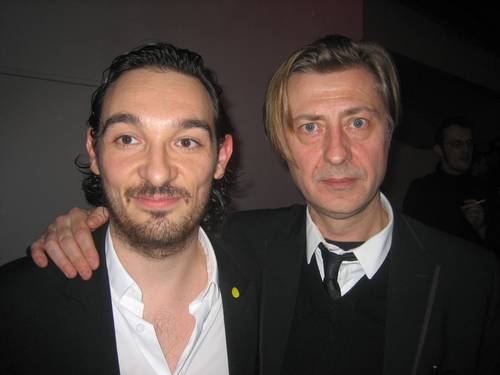FRENCH CRED PUBLISHED IN "SCENE & HERD" SECTION, WWW.ARTFORUM.COM

The second-floor private cocktail lounge proved at first a safe haven from the masses, and the invited guests were plied with free champagne and sandwiches. But the sense of security soon morphed into dread as the teeming masses trying to squeeze up the stairs made it impossible to exit. After a while, security guards refused to let anyone up or down. Sans and Bourriaud were trapped upstairs, along with fashion design legend Jean-Charles de Castelbajac, artists Clemens von Wedemeyer and Elaine Sturtevant, curator Natasa Petresin, film producer Claude Berri, graphic designer Mathias Augustyniak, one or two supermodels, and—of course—dealers, including Emmanuel Perrotin, Kamel Mennour, Art:Concept's Daniele Balice, Yvon Lambert's Denis Gaudel, and Cosmic Gallery's Frédéric Bugada and Claudia Cargnel.
Left: Jérôme Sans with fashion designer Jean-Charles de Castelbajac. Right: Model and photographer Astrid Muñoz with "Notre Histoire..." artist Matthieu Laurette.
It seemed like the entire Paris art community found a perch in this lounge. But perhaps that made space on the exhibition floor for international visitors, as the directors' farewell exhibition is driven by a wish to internationalize their hometown's emerging-art scene. "Notre Histoire . . ." is the opening salvo of a major plan, supported by governmental means, to promote French culture at home and abroad: Three more large exhibitions, including surveys of French artists at the Pompidou and the Grand Palais, will take place in 2006, and next year "Made in France," a cross-disciplinary festival, will traverse the channel to play at UK venues. In an odd paean to this internationalist push, French curators and writers were not invited to write texts about the artists in the exhibition catalogue. Yet the show's wall labels are presented only in French, and there are no subtitles for video pieces. Is this paradox emblematic of the difficulty Sans and Bourriaud may have faced with their mission? The local critic Thomas Boutoux offered a terse opinion on a compromise between rhetoric and reality: "This exhibition perfectly summarizes their overall program: neither as experimental or distinctive as hoped, but rather fawning and ultimately very crowd-pleasing."
Later on, getting beyond the velvet ropes at the (in)famous and exclusive nightclub Le Baron on avenue Marceau was easier if one knew Benjamin Moreau and Samuel Boutruche, two hip "Notre Histoire" artists who collaborate as "Kolkoz" and are a part of the the club's "crew." (Some may remember their five-night early-December residency behind the decks at a temporary Le Baron in Miami Beach's Shelburne Hotel.) Only a fraction of the overwhelmingly French crowd was admitted, but their numbers amounted to many more than the 110-person maximum capacity. Once inside, a French dealer politely asked me to not write anything remotely negative about the exhibition in an international venue, since this would be "the last thing France needs after all the negative stuff that has been said lately about the French and Paris. Especially after the riots in the suburbs and all . . ." His jitters made me appreciate the virtue of the Palais de Tokyo's first four years: It made French art seem relevant enough to get an out-of-towner like me to make the trek for this event. Marc-Olivier Wahler, the artistic director at New York's Swiss Institute and the Palais de Tokyo's incoming director, could have inherited worse.
—Power Ekroth
